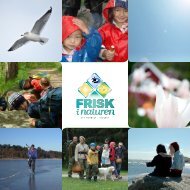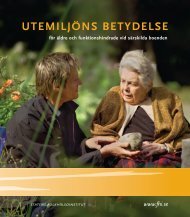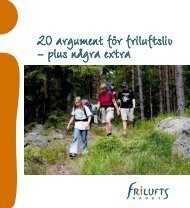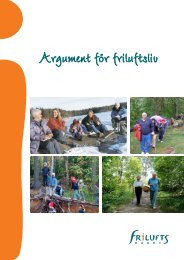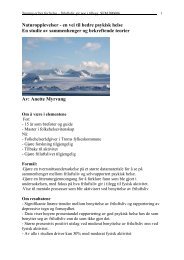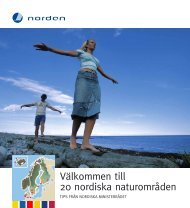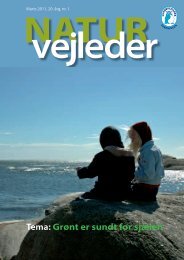Green Care: A Conceptual Framework - Frisk i naturen
Green Care: A Conceptual Framework - Frisk i naturen
Green Care: A Conceptual Framework - Frisk i naturen
You also want an ePaper? Increase the reach of your titles
YUMPU automatically turns print PDFs into web optimized ePapers that Google loves.
in urban and rural areas, and often it is those who do not access nature<br />
who could benefit from it the most. These barriers are varied and recent<br />
studies have shown that there are physical, social and cultural reasons why<br />
people do not access nature, even if there are local greenspaces present<br />
(see: Countryside Recreation Network. 2001; Pretty et al, 2005). When<br />
deciding on or developing a greenspace to be used for green care activities,<br />
maximum accessibility and inclusion will be achieved when these barriers<br />
are addressed.<br />
Accessibility is therefore a factor of person-environment fit and refers to<br />
the degree to which people with different abilities are able to access the<br />
environment. Physical accessibility is often emphasized due to planning<br />
norms or regulation in different countries; cognitive accessibility refers<br />
to the environment in which the information needed to move and act is<br />
understandable to the users; and social accessibility includes welcoming<br />
atmosphere and the feelings of security and safety.<br />
In green care environments different levels of accessibility can be<br />
implemented depending on the functional abilities and needs of clients<br />
and the targets of interventions. The norms for physical accessibility are<br />
relatively universal, so they can be applied rather broadly in different<br />
environments and concern the dimensions, inclination and deviation of<br />
pathways, paving materials, and colours, the placement of signing and<br />
resting places and what kind of furnishing to use (for example, SuRaKu,<br />
2008). Practical considerations regarding vegetation would preclude<br />
poisonous, thorny and common plants causing allergic reactions; plants<br />
which drop their fruits or berries on the pathways; dense vegetation<br />
which may obstruct movement and visual exploration. In addition to<br />
practical considerations, participants must also feel welcomed and safe,<br />
in a culturally sensitive environment and at ease in the chosen natural<br />
environment. Physical, cognitive and social accessibility are particularly<br />
important considerations for green care where greenspaces are targeted for<br />
use by vulnerable people.<br />
5.3.2 Urban greening<br />
In addition to providing accessible greenspaces for urban populations, and<br />
for use in green care settings, the ‘greening’ of our cities can bring varied<br />
environmental, health, economic and social benefits and so can contribute<br />
60 <strong>Green</strong> <strong>Care</strong>: A <strong>Conceptual</strong> <strong>Framework</strong>



